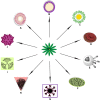Nanotechnology-based approaches in anticancer research
- PMID: 22927757
- PMCID: PMC3420598
- DOI: 10.2147/IJN.S33838
Nanotechnology-based approaches in anticancer research
Abstract
Cancer is a highly complex disease to understand, because it entails multiple cellular physiological systems. The most common cancer treatments are restricted to chemotherapy, radiation and surgery. Moreover, the early recognition and treatment of cancer remains a technological bottleneck. There is an urgent need to develop new and innovative technologies that could help to delineate tumor margins, identify residual tumor cells and micrometastases, and determine whether a tumor has been completely removed or not. Nanotechnology has witnessed significant progress in the past few decades, and its effect is widespread nowadays in every field. Nanoparticles can be modified in numerous ways to prolong circulation, enhance drug localization, increase drug efficacy, and potentially decrease chances of multidrug resistance by the use of nanotechnology. Recently, research in the field of cancer nanotechnology has made remarkable advances. The present review summarizes the application of various nanotechnology-based approaches towards the diagnostics and therapeutics of cancer.
Keywords: cancer; diagnosis; drug delivery; nanoparticle; nanotechnology; treatment.
Figures

Similar articles
-
Update on Nanotechnology-based Drug Delivery Systems in Cancer Treatment.Anticancer Res. 2017 Nov;37(11):5975-5981. doi: 10.21873/anticanres.12044. Anticancer Res. 2017. PMID: 29061776 Review.
-
Cancer chemoprevention by polyphenols and their potential application as nanomedicine.J Environ Sci Health C Environ Carcinog Ecotoxicol Rev. 2013;31(1):67-98. doi: 10.1080/10590501.2013.763577. J Environ Sci Health C Environ Carcinog Ecotoxicol Rev. 2013. PMID: 23534395 Review.
-
Nanotechnology Approaches to Improving Cancer Immunotherapy.Adv Cancer Res. 2018;139:35-56. doi: 10.1016/bs.acr.2018.05.003. Epub 2018 Jun 7. Adv Cancer Res. 2018. PMID: 29941106 Free PMC article. Review.
-
Safe Nanoparticles: Are We There Yet?Int J Mol Sci. 2020 Dec 31;22(1):385. doi: 10.3390/ijms22010385. Int J Mol Sci. 2020. PMID: 33396561 Free PMC article. Review.
-
Nanotechnology: Future of Oncotherapy.Clin Cancer Res. 2015 Jul 15;21(14):3121-30. doi: 10.1158/1078-0432.CCR-14-1189. Clin Cancer Res. 2015. PMID: 26180057 Free PMC article. Review.
Cited by
-
Toxicity testing of indocyanine green and fluorodeoxyglucose conjugated iron oxide nanoparticles with and without exposure to a magnetic field.Asian J Nanosci Mater. 2021 Jul;4(3):229-239. doi: 10.26655/AJNANOMAT.2021.3.5. Epub 2021 May 27. Asian J Nanosci Mater. 2021. PMID: 38192303 Free PMC article.
-
Caveolin-1 and CDC42 mediated endocytosis of silica-coated iron oxide nanoparticles in HeLa cells.Beilstein J Nanotechnol. 2015 Jan 14;6:167-76. doi: 10.3762/bjnano.6.16. eCollection 2015. Beilstein J Nanotechnol. 2015. PMID: 25671161 Free PMC article.
-
Synthetic Receptor-Based Targeting Strategies to Improve Tumor Drug Delivery.AAPS PharmSciTech. 2021 Mar 8;22(3):93. doi: 10.1208/s12249-021-01919-w. AAPS PharmSciTech. 2021. PMID: 33683499 Review.
-
Evaluation of Silver Nanoparticles Caffeic Acid Complex Compound as New Potential Therapeutic Agent against Cancer Incidence in Mice.Asian Pac J Cancer Prev. 2021 Oct 1;22(10):3189-3201. doi: 10.31557/APJCP.2021.22.10.3189. Asian Pac J Cancer Prev. 2021. PMID: 34710995 Free PMC article.
-
Mitochondria Targeted Protein-Ruthenium Photosensitizer for Efficient Photodynamic Applications.J Am Chem Soc. 2017 Feb 15;139(6):2512-2519. doi: 10.1021/jacs.6b13399. Epub 2017 Feb 7. J Am Chem Soc. 2017. PMID: 28097863 Free PMC article.
References
-
- Feinberg AP, Ohlsson R, Henikoff S. The epigenetic progenitor origin of human cancer. Nat Rev Genet. 2006;7(1):21–33. - PubMed
-
- Ferlay J, Shin HR, Bray F, Forman D, Mathers C, Parkin DM. Estimates of worldwide burden of cancer in 2008: GLOBOCAN 2008. Int J Cancer. 2010;127(12):2893–2917. - PubMed
-
- American Cancer Society . Cancer Facts and Figures 2011. Atlanta, GA: American Cancer Society; 2011.
Publication types
MeSH terms
LinkOut - more resources
Full Text Sources
Miscellaneous

